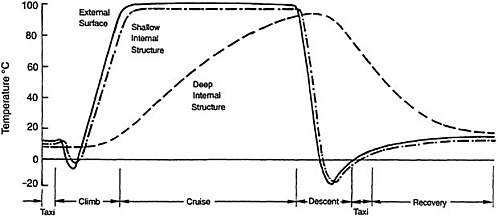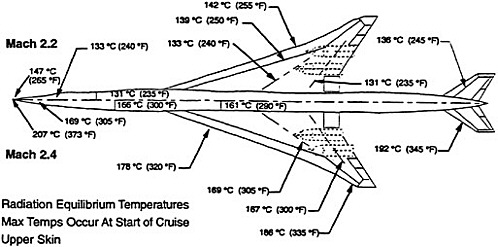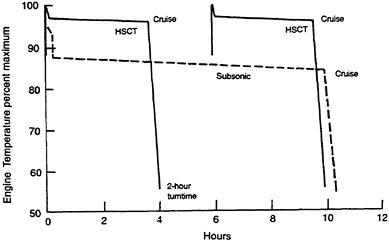2
Aircraft Operating Environment
The first step in characterizing the aging of a material or structural component is to define the operating environment as precisely as possible. For new applications, this proves very difficult, since actual data are scarce and conditions are defined largely through estimates or analyses. Among the variables that need to be considered for the HSCT (High-Speed Civil Transport) are operating temperatures, loads, ambient environmental conditions, moisture and fluid exposures, radiation, maintenance, and ground handling. This chapter describes the factors that influence service conditions of supersonic, commercial aircraft. Some of the experience gained from the Concorde is described, followed by a discussion of the key variables that need to be considered to determine conditions expected for the HSCT.
THE CONCORDE EXPERIENCE
The typical mission of the Concorde, a long-range (trans-Atlantic) flight profile involving sustained cruising speed above Mach 2.0, was described by Harpur (1968). Like subsonic aircraft, the Concorde experiences variations in stress and temperature during flight; however, the airframe temperature variations are much more significant than for subsonic aircraft due to the effect of aerodynamic heating at supersonic speeds.
The skin temperature drops initially as the aircraft climbs due to exposure to decreasing ambient air temperatures. As the speed increases above about Mach 1, where the temperature begins to increase, the skin temperature reaches a maximum of 120°C (248°F) after exposure while cruising at Mach 2.2. (At Mach 2.0, the skin temperature would stay below 100°C (212°F); at Mach 2.4, it would reach 150°C (302°F.) During descent, the reverse occurs. Significant stresses also occur in supersonic aircraft because of thermal variations. Differences in temperature throughout the structure cause different parts of the structure to expand by different amounts, giving rise to thermal stresses which are added to the other imposed stresses. Figure 2-1 shows the predicted, maximum external surface temperature of the Concorde due to aerodynamic heating. Figure 2-2 shows a thermal profile due to exposure for a complete Concorde flight cycle.
Superimposed on this once-per-fright thermal cycle are stress variations. Once per flight, there is stress variation due to cabin pressurization and depressurization, as well as stresses that occur during take-off and landing. In addition, there are stresses due to maneuvering and gusts, but these are not expected to be as significant to supersonic aircraft as they are to subsonic aircraft.
HSCT CONDITIONS
Ground Exposure
Two types of ground exposure that must be considered are ambient environmental conditions and the potential for

FIGURE 2-1 External structural temperature during cruise for the Concorde. Source: Peel (1994). © British Crown Copyright, 1971, Defence Evaluation and Research Agency. Reproduced with permission of the Controller, Her Britannic Majesty's Stationery Office.

FIGURE 2-2 Structural temperature for a typical flight of the Concorde. Source: Peel (1994). © British Crown Copyright, 1971, Defence Evaluation and Research Agency. Reproduced with the permission of the Controller, Her Brittannic Majesty's Stationery Office.
damage caused by maintenance and repair actions as well as handling (or mishandling) considerations.
Ground ambient exposure for commercial and military aircraft have been studied extensively (McCarty and Wilson, 1983). Exposure to extremes in temperature (ranging from about 60°C to −30°C [140°F to −22°F]), moisture (extreme humidity to desert conditions), and radiation (especially ultra-violet) can cause degradation of coatings and structural materials or exacerbate the damaging effects of flight exposure conditions.
Discrete damage events, both on the ground and in flight, represent a threat to polymeric composite and thin-skinned components. Sources of discrete damage include hail impact, lightning strike, transport and handling, and foreign objects (Blohm, 1994).
Airline maintenance operations can also have a profound effect on materials aging. The integrity of finish systems or of delicate minimum-gauge components can be degraded due to airline maintenance and servicing operations. A study by IATA (1991) indicated that as much as 40 percent of aircraft damage requiring repair is due to ramp and maintenance damage from such sources as catering equipment and personnel, baggage loaders, lavatory and potable water service, and jetway interfaces. Chemicals encountered in aircraft servicing, including cleaning fluids, fuel, de-icing and anti-icing fluids, paint strippers, and hydraulic oils, need to be identified and the effect on finishes and components assessed.
Another consideration is the integrity of repairs that are made to structural components during airline service. Most aging models assume that the structure would remain in

FIGURE 2-3 Predicted equilibrium skin temperatures for a Mach 2.2 and Mach 2.4 HSCT. Source: Brunner (1994).
as-fabricated condition. Since in-service damage and subsequent repairs are inevitable, the effect of in-service repairs should to be considered.
Flight Exposure
Airframe
In general, the most severe service conditions are encountered during flight. For supersonic aircraft, the flight-cycle conditions are determined by speed at cruise, altitude, flight loads, and spike (or failure) conditions. The HSCT will be designed for a lifetime of approximately 20,000 flight cycles, which for a typical service cycle represents about 60,000 flight hours (Brunner, 1994). A substantial portion of this flight cycle will be under supersonic cruise conditions at speeds between Mach 2 and Mach 2.4.
The expected flight cycle for the HSCT will be similar to the Concorde cycle described earlier in this chapter, except:
-
higher speeds at cruise will necessitate higher cruise altitudes, and
-
the significantly greater range will result in longer typical times at cruise conditions.
Higher cruise altitudes will result in a less oxidative environment due to reduced atmospheric pressure (and correspondingly lower oxygen concentration) as altitude increases. Since there has been little work in characterization of highaltitude environments, progress is needed to better define these conditions.
The HSCT flight cycle imposes a range of thermal environments on structures. As observed for the Concorde, subsonic climb and cruise conditions lead to reduced temperatures due to lower ambient temperatures as the altitude increases. Structures on current commercial aircraft are generally designed to withstand low-temperature exposures to −54°C (−65 °F).
The most severe service conditions for the HSCT are the high-temperature exposures due to the aerodynamic heating that results from supersonic cruise. The highest temperatures occur at the leading edges of the structure. Component temperatures increase significantly as speed increases. An estimate of HSCT surface temperature distribution is shown in Figure 2-3 for Mach 2.2 and 2.4 configurations. Surface temperatures are strongly dependant on altitude, angle of attack, radiation conditions, and surface emissivity of both bare and painted surfaces. To fully characterize thermal exposures, thermal and optical properties of the candidate structural materials and surface finishes as well as heat-transfer behavior characteristics must be understood.
In addition to mechanical load conditions encountered in flight, designers must also account for thermal expansion effects and thermal expansion mismatches between adjacent structures. Current methods can model expected loads, but the thermal environment and heat-transfer characteristics must be well understood to provide complete information.
Occasional thermal spikes may be encountered due to rapid descents. These conditions may result in the aircraft attaining speeds 10 percent higher than the design maximum with resulting effects on aerodynamic heating. The structure must be able to retain structural properties under these conditions without sustaining permanent damage. Response of materials subjected to thermal spike conditions (rapid heating, rapid loading) must be understood.
Engine
Flight conditions expected for the engines of the HSCT, as for the airframe, are more severe than current applications (Williams and Johnson, 1994). The expected temperatures in the combustor section are significantly higher than current subsonic engines—1540–1650°C (2800–3000°F) for the HSCT compared with approximately 1425°C (2600°F) for current commercial aircraft engines. The more-severe conditions are driven largely by design requirements for low NOx emissions combustors and low-noise exhaust nozzles. The duty cycle for the HSCT engine also requires operation for a greater percentage of time at temperatures closer to maximum than current commercial or military engines. A comparison of HSCT and current commercial engine cycles is shown in Figure 2-4.
SUMMARY AND RECOMMENDATION
The expected service environment for the HSCT has been the subject of a significant amount of work by aircraft

FIGURE 2-4 Comparison of HSCT and subsonic engine duty cycle for comparable 5,000 nm flights. Source: Williams and Johnson (1994).
manufacturers (Brunner, 1994; Grande, 1994). Understanding typical service conditions is also crucial to NASA efforts to establish goals and criteria for research in enabling HSCT technologies.
An accurate understanding of expected service conditions is crucial in the selection of structural materials, the identification of design criteria, and the testing and evaluation of structural concepts. Conditions for new applications are defined largely through estimates or analysis. Among the variables that must be considered for the high-speed aircraft applications are operating temperatures, loads, ambient environmental conditions, moisture and fluid exposures, radiation, maintenance, and ground handling.
-
The committee recommends that airframe and engine manufacturers, with assistance from NASA, continue to improve their understanding of the service environment expected for future high-speed aircraft. Emphasis should be placed on the analysis of aerothermal and chemical interactions and heat transfer to better define component temperature and thermal gradients and on characterization of ambient exposure conditions throughout the typical flight regimes.
The range of thermal, mechanical, and environmental conditions described in this chapter and the complex interactions among them makes the HSCT an instructive case study in the examination of materials aging responses. The following chapter describes how, based on the HSCT conditions, materials candidates have been identified. Subsequent chapters discuss the evaluation and characterization of materials degradation and aging responses.




